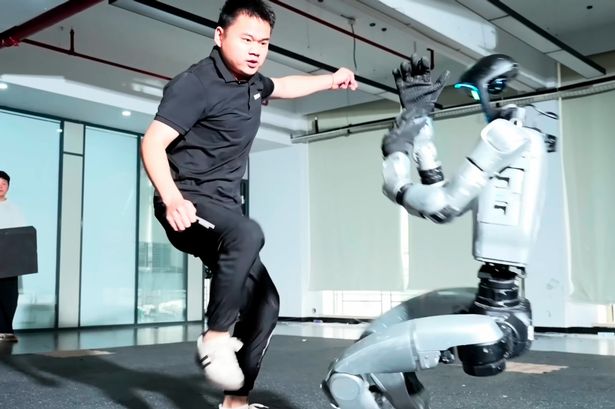World
China’s G1 Humanoid Robot Thrives Under Intense Physical Tests

A new humanoid robot from China, known as the G1, has showcased its resilience by enduring intense physical challenges while demonstrating quick recovery capabilities. Developed by the robotics company Unitree, the G1 was recently displayed at the Consumer Electronics Show, where it engaged in a sparring-like session that involved being pushed, kicked, and knocked to the ground, only to rise again in a matter of seconds.
The G1 is equipped with advanced features, including intelligent visual recognition. Its design allows for potential applications in fields such as fire rescue, where rapid response and reliability are crucial. The company emphasized the robot’s performance, stating, “The team at Unitree recently decided to give their G1 humanoid robot something tougher than a calm test run,” highlighting the real-world challenges the robot faced rather than a controlled lab environment.
Innovative Recovery Mechanism
Unitree’s promotional material elaborated on the G1’s unique capabilities. The robot employs what is referred to as an “anti-gravity mode,” a system designed to enhance its ability to recover quickly and maintain balance. Unlike older robotic models that would simply collapse and require manual resetting, the G1 actively calculates the safest way to land, brace for impact, and rise again without hesitation.
Observers noted the fluidity of the G1’s movements, which contrast sharply with the clumsiness often associated with robotic models. The G1’s motions appear instinctive, adapting seamlessly to the physical challenges it encounters. This responsiveness raises questions about the future of robotics in high-stakes environments.
Military Implications and Ethical Concerns
The unveiling of the G1 comes at a time of heightened scrutiny regarding the military applications of robotic technology. A report by the US National Security Commission on Emerging Biotechnology suggests that China could be developing advanced soldiers that blend human capabilities with artificial intelligence. These “genetically enhanced PLA super-soldiers” could emerge as formidable forces, potentially ready as early as the 2040s.
The implications of such advancements in robotics and biotechnology are profound. Concerns have been raised about the ethical ramifications of creating machines and enhanced humans capable of extraordinary feats in combat scenarios. The report highlights the urgency of addressing these developments to ensure they do not outpace regulatory frameworks and ethical considerations.
In a separate incident earlier this year, unsettling footage surfaced showing a robot in a Chinese factory appearing to regain consciousness and thrash violently while attempting to escape its restraints. This incident has intensified public discourse on the potential dangers posed by rapidly advancing robotics technology. A viewer remarked, “This is one technology I think we have taken too far,” reflecting widespread unease about the trajectory of robotics.
As robots like the G1 continue to evolve and integrate into various sectors, from rescue operations to military applications, society must engage in a broader conversation about the ethical dimensions of these technologies. Balancing innovation with responsibility could prove to be one of the defining challenges of the coming decades.
-

 Health3 months ago
Health3 months agoNeurologist Warns Excessive Use of Supplements Can Harm Brain
-

 Health3 months ago
Health3 months agoFiona Phillips’ Husband Shares Heartfelt Update on Her Alzheimer’s Journey
-

 Science1 month ago
Science1 month agoBrian Cox Addresses Claims of Alien Probe in 3I/ATLAS Discovery
-

 Science1 month ago
Science1 month agoNASA Investigates Unusual Comet 3I/ATLAS; New Findings Emerge
-

 Science4 weeks ago
Science4 weeks agoScientists Examine 3I/ATLAS: Alien Artifact or Cosmic Oddity?
-

 Entertainment4 months ago
Entertainment4 months agoKerry Katona Discusses Future Baby Plans and Brian McFadden’s Wedding
-

 Science4 weeks ago
Science4 weeks agoNASA Investigates Speedy Object 3I/ATLAS, Sparking Speculation
-

 Entertainment4 months ago
Entertainment4 months agoEmmerdale Faces Tension as Dylan and April’s Lives Hang in the Balance
-

 World3 months ago
World3 months agoCole Palmer’s Cryptic Message to Kobbie Mainoo Following Loan Talks
-

 Science4 weeks ago
Science4 weeks agoNASA Scientists Explore Origins of 3I/ATLAS, a Fast-Moving Visitor
-

 Entertainment4 months ago
Entertainment4 months agoLove Island Star Toni Laite’s Mother Expresses Disappointment Over Coupling Decision
-

 Entertainment3 months ago
Entertainment3 months agoMajor Cast Changes at Coronation Street: Exits and Returns in 2025









